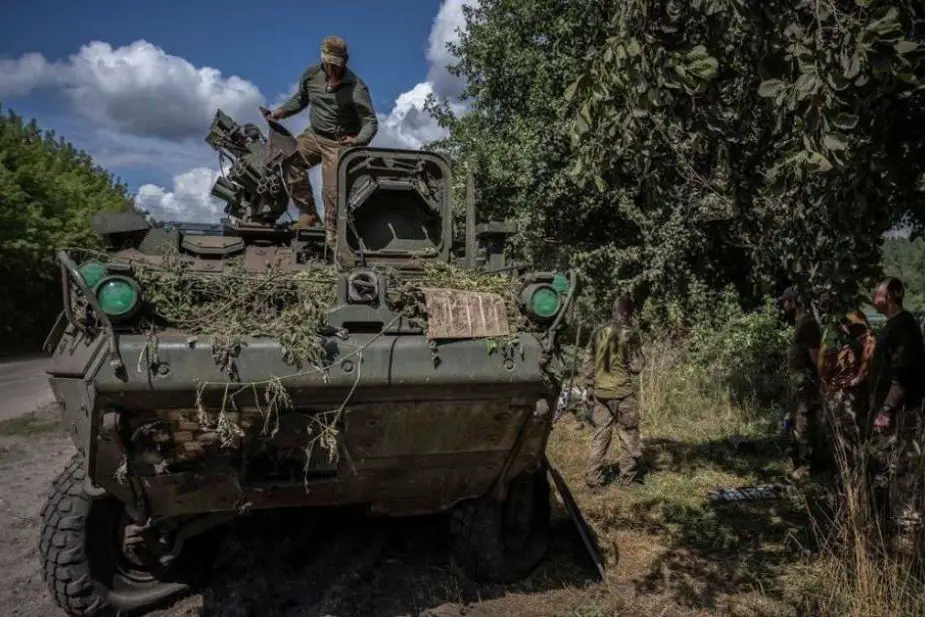Breaking News
Ukrainian US-Donated Stryker Armored Vehicles Show High Combat Effectiveness in Kursk Operation.
The combat capabilities of the U.S.-donated Stryker M1126 Infantry Carrier Vehicle (ICV) have proven highly efficient during the Ukrainian forces' operations near Kursk, on Russian territory. The Stryker’s advanced design and robust performance have allowed it to excel in the demanding battlefield environment, providing Ukrainian troops with a crucial tactical advantage. Its state-of-the-art thermal sensors have been particularly effective, enabling Ukrainian commanders to detect and engage Russian forces from distances beyond the enemy's detection capabilities. This technological superiority has been critical in ensuring that the Stryker units can maneuver with confidence and strike decisively.
Follow Army Recognition on Google News at this link

A M1126 Stryker from the Ukrainian 82nd Airborne Assault Brigade was struck by an RPG in the Kursk Region. Despite the hit, the crew survived, though the driver suffered a concussion. (Picture source: X Social Network)
These capabilities have been further amplified by the Stryker's ability to coordinate rapid and precise artillery strikes, including the use of ATACMS (Army Tactical Missile System). The combination of superior reconnaissance and firepower has allowed Ukrainian forces to maintain their offensive momentum, effectively targeting and neutralizing enemy positions with precision. Ukrainian commanders also have been able to detect Russian forces at distances beyond the reach of the enemy's detection capabilities, thanks to the advanced thermal sensors on Stryker units.
The United States has donated a significant number of Stryker armored vehicles to Ukraine as part of its military aid packages. The first batch of these vehicles was announced in January 2023 as part of a $2.5 billion aid package, which included 90 Stryker armored personnel carriers. This marked the first time the U.S. provided Strykers to Ukraine. Later in 2023, additional shipments brought the total number of Stryker vehicles donated to 157 by March 2023.
The M1126 Stryker is a highly capable eight-wheeled armored fighting vehicle, designed to balance protection, firepower, mobility, and advanced optics. In terms of protection, the Stryker's hull is made from high-hardness steel, offering defense against small arms fire, artillery fragments, and improvised explosive devices (IEDs). It can be further enhanced with additional ceramic armor, known as "slat armor," which improves its resistance to rocket-propelled grenades (RPGs). The vehicle also includes an automatic fire suppression system and nuclear, biological, and chemical (NBC) protection for the crew, ensuring survivability in various combat conditions.
Regarding firepower, the M1126 Stryker is typically armed with a remotely operated M2 .50 caliber heavy machine gun or a Mk 19 40mm automatic grenade launcher. These weapons are mounted on the Protector Remote Weapon Station (RWS), which allows the gunner to operate the system from within the safety of the vehicle. This configuration provides effective firepower while protecting the crew. Some variants of the Stryker are equipped with a 30mm autocannon, which enhances its capability to engage both infantry and light armored vehicles.
The vehicle's optics and sensors are advanced, contributing significantly to its situational awareness and target acquisition abilities. The RWS features day and night cameras, a thermal imaging system, and a laser rangefinder, enabling the Stryker to engage targets effectively in various visibility conditions. Additionally, the vehicle is integrated with a battlefield management system that provides real-time data, allowing the crew to make quick, informed decisions.
In terms of mobility, the Stryker is powered by a Caterpillar 3126 turbo diesel engine, producing 350 horsepower, which allows it to reach speeds of up to 97 km/h on roads. Its eight-wheel drive system and central tire inflation system provide superior maneuverability across different terrains, including mud, snow, and sand. Furthermore, the Stryker can be airlifted by a C-130 Hercules transport aircraft, enhancing its strategic mobility and deployability in various operational environments.
The U.S.-donated Stryker M1126 Infantry Carrier Vehicle (ICV) offers significant advantages over the older Soviet-made wheeled armored personnel carriers (APCs) used by Ukrainian forces. One of the primary benefits is its superior protection and survivability. The Stryker's modular armor system, which can be enhanced with additional ceramic or slat armor, provides greater defense against small arms fire, artillery fragments, and anti-tank rockets. In contrast, many Soviet-era APCs, like the BTR series, are equipped with thinner armor, making them more vulnerable in modern combat situations.
Additionally, the Stryker excels in mobility and tactical flexibility. Its eight-wheeled drive system, powered by a robust turbo diesel engine, ensures excellent maneuverability and speed across various terrains. This mobility advantage allows the Stryker to perform effectively in diverse battlefield conditions, whereas Soviet-made APCs, which often lack advanced features like a central tire inflation system, can struggle in challenging environments. Together, these factors make the Stryker a more versatile and resilient option for the Ukrainian military, offering enhanced operational capabilities compared to their older, Soviet-era counterparts.


























